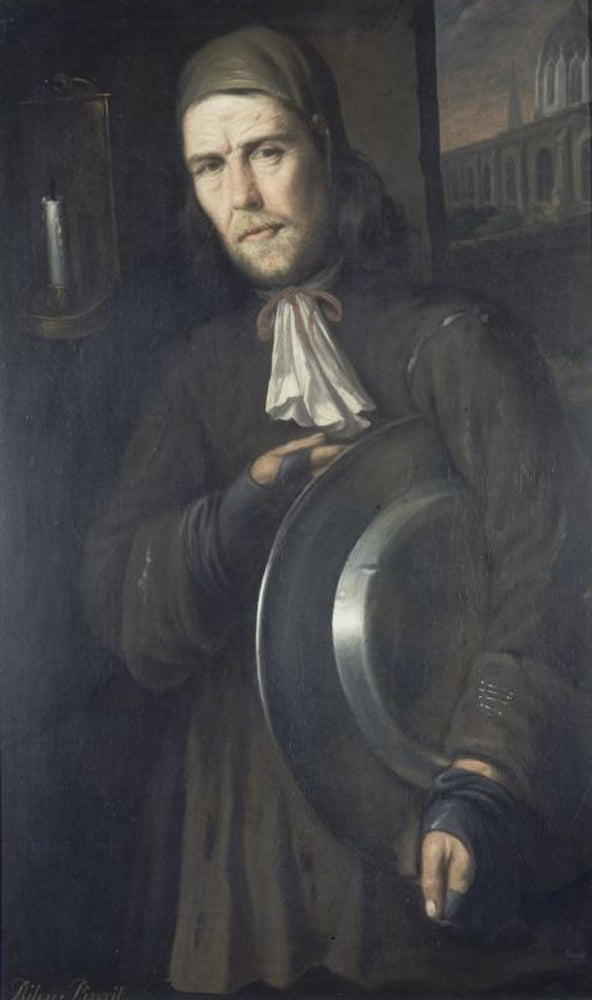Riley, John: The Scullion at Christ Church (1680s)
The Independent's Great Art series

Works of art don't always make sense. They go over the top or off the point. They introduce intensities that seem excessive, irrelevant, given the matter in hand. They embark on flights of their own. And because we can't quite understand why things are being invested with so much emotion or sensation, the work's power also holds a feeling of mystery.
It needn't take a very great work to achieve this, either. John Riley is a minor British painter and his portrait of a veteran Oxford college servant, The Scullion at Christ Church, is mostly a workmanlike painting. All the same, it is a real painting. It holds an intensity way beyond what this sort of picture requires.
We normally approach historical representation of the lower classes in a moral manner. The scullion is a pretty menial kind of servant. So does the picture mock this man? Does it sentimentalise him? Or does it confer dignity upon him? We like it when the old masters seem to anticipate our own democratic attitudes.
Actually, in this case, dignity may be hard to distinguish from something more feudal. If the scullion looks like a serious and resolute man, the moral may only be that he is a very good, honest, loyal, dependable servant – not that he deserves full human rights. The type of picture, in other words, works as a character reference.
But when you ask, what does the painting itself dwell on, what does it pay attention to and draw our attention to, the answer is rather different. It stresses the look on a human face, and the shine on a metal plate. Those are the two features that glow most prominently from this darkened scene.
Other things appear, too, less emphatically: the white neckerchief, the two hands in their leather half-gloves. And these five elements – face, kerchief, right hand, gleam, left hand – lie in a descending straight line, which itself lies at a slight slant from the vertical. Its angle of lean is the same as the tilt of the man's head and neckerchief.
So there is this conspicuous bit of design. Five things, which might easily and realistically have been laid out more randomly, all line up. It's a visual effect that holds the picture together. It can also be understood as a visual metaphor, an arrangement that enacts the character of the man.
It makes you feel that he himself is straight, steady, upstanding, coordinated. And of course he is shown in the act of holding something, and his job involves maintaining things in their proper state, so the metaphor has a ready purchase. The alignment conveys that this is a solid, reliable servant. The picture is making sense.
There are other effects, though, that don't translate quite so promptly. For example, there's a resonance between the hard, rounded edges of the half-gloves, which press into the flesh of his hands – and the hard, curved, gleaming rim of the plate, which doesn't press against anything, but is visibly, sharply tangible.
Still, if you're after making sense, you could say that this sensation-simile – hard edge by hard edge – is another metaphor. It brings out the nature of the scullion's tough character and hard work, and associates his body with the objects he deals with. His hands are as hard as the plate he polishes.
OK, but what about the larger simile, that dominates Riley's portrait – the resonance between the expression on the scullion's face, and the major highlight on the pewter plate? Does that signify anything?
True, you may not notice this resonance at all, and it sounds weird when it's just described. How could a look be like a gleam? But the picture makes them like. The flexing of the man's cheek muscles, the beetling of his brow, the tense focusedness of his face, is – somehow – analogous to the growing brightness of the light reflected off the metal. It's probable that both phenomena carry a feeling of tightening, convergence, coming to a point. Also, the glare of the highlight comes out at us, as does the man's gaze.
This inter-reaction between look and shine intensifies them both – and when you do notice it, it becomes the overriding effect in The Scullion at Christ Church. It steals the scene. And it too can be turned into a character metaphor: the man has a "steely" gaze, if you will.
Except that the effect feels bigger than that sort of point making. It is one of those mysteriously excessive or irrelevant intensities. It doesn't tell you anything about the picture's subject. It doesn't contribute to questions about the representation of servants. It is simply what makes the painting worth looking at.
The artist
John Riley (1646-91) is an artist who'd be unlikely to appear in the art history of any land but Britain. Nothing flashy, perfectly competent, in his day he was our leading portrait painter. But the works for which he is most celebrated now are his least characteristic – two servant portraits, one The Scullion, the other of Bridget Holmes, an ancient royal housemaid, who is depicted mimicking the pose of a formal aristocratic portrait. But there was a gallery of royal and noble mugshots, too. His portrait of Charles II provoked a famous kingly remark, (which remains Riley's most famous moment). "Is this like me? Then, odd's fish, I am an ugly fellow."
Join our commenting forum
Join thought-provoking conversations, follow other Independent readers and see their replies
Comments
Bookmark popover
Removed from bookmarks